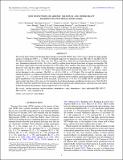NEW DETECTIONS OF ARSENIC, SELENIUM, AND OTHER HEAVY ELEMENTS IN TWO METAL-POOR STARS
Author(s)
Roederer, Ian U.; Schatz, Hendrik; Lawler, James E.; Beers, Timothy C.; Cowan, John J.; Frebel, Anna L.; Ivans, Inese I.; Sneden, Christopher; Sobeck, Jennifer S.; ... Show more Show less
DownloadRoederer-2014-NEW DETECTIONS OF AR.pdf (871.1Kb)
PUBLISHER_POLICY
Publisher Policy
Article is made available in accordance with the publisher's policy and may be subject to US copyright law. Please refer to the publisher's site for terms of use.
Terms of use
Metadata
Show full item recordAbstract
We use the Space Telescope Imaging Spectrograph on board the Hubble Space Telescope to obtain new high-quality spectra covering the 1900 ≤λ ≤ 2360 Å wavelength range for two metal-poor stars, HD 108317 and HD 128279. We derive abundances of Cu II, Zn II, As I, Se I, Mo II, and Cd II, which have not been detected previously in either star. Abundances derived for Ge I, Te I, Os II, and Pt I confirm those derived from lines at longer wavelengths. We also derive upper limits from the non-detection of W II, Hg II, Pb II, and Bi I. The mean [As/Fe] ratio derived from these two stars and five others in the literature is unchanged over the metallicity range –2.8 < [Fe/H] <–0.6, lang[As/Fe]rang = +0.28 ± 0.14 (σ = 0.36 dex). The mean [Se/Fe] ratio derived from these two stars and six others in the literature is also constant, lang[Se/Fe]rang = +0.16 ± 0.09 (σ = 0.26 dex). The As and Se abundances are enhanced relative to a simple extrapolation of the iron-peak abundances to higher masses, suggesting that this mass region (75 ≤A ≤ 82) may be the point at which a different nucleosynthetic mechanism begins to dominate the quasi-equilibrium α-rich freezeout of the iron peak. lang[Cu II/Cu I]rang = +0.56 ± 0.23 in HD 108317 and HD 128279, and we infer that lines of Cu I may not be formed in local thermodynamic equilibrium in these stars. The [Zn/Fe], [Mo/Fe], [Cd/Fe], and [Os/Fe] ratios are also derived from neutral and ionized species, and each ratio pair agrees within the mutual uncertainties, which range from 0.15 to 0.52 dex.
Date issued
2014-07Department
Massachusetts Institute of Technology. Department of Physics; MIT Kavli Institute for Astrophysics and Space ResearchJournal
Astrophysical Journal
Publisher
Institute of Physics/American Astronomical Society
Citation
Roederer, Ian U., Hendrik Schatz, James E. Lawler, Timothy C. Beers, John J. Cowan, Anna Frebel, Inese I. Ivans, Christopher Sneden, and Jennifer S. Sobeck. “NEW DETECTIONS OF ARSENIC, SELENIUM, AND OTHER HEAVY ELEMENTS IN TWO METAL-POOR STARS.” The Astrophysical Journal 791, no. 1 (July 23, 2014): 32. © 2014 American Astronomical Society.
Version: Final published version
ISSN
0004-637X
1538-4357